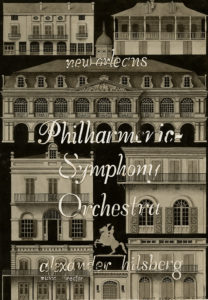New Orleans Philharmonic Symphony
Founded in 1936, the New Orleans Philharmonic Symphony permanently suspended operations in 1991.

Courtesy of The Historic New Orleans Collection
New Orleans Philharmonic Symphony Orchestra. Cruise, Boyd (Artist)
Founded in 1936, the New Orleans Philharmonic Symphony was the successor of several earlier orchestras—among them the New Orleans Symphony Orchestra, organized in 1910 under the baton of Severin O. Frank, and the Crescent City Symphony, organized in 1916 under the direction of Ernest E. Schuyten. He would go on to become the conductor of his newly founded New Orleans Symphony Orchestra Association in 1926. There appears to have been a hiatus in performance between 1927 and 1930, when Maestro Schuyten reintroduced the New Orleans Symphony Orchestra, but the revived organization performed only twice before fading away again.
In 1935 a new orchestra, the New Orleans Civic Symphony, came into existence with the arrival of Russian cellist Arthur Zack. It remained active, if fiscally fragile, until 1939, when a series of privately funded competing concerts led by Norwegian conductor Ole Windingstad threatened the financial viability of the Civic Symphony. This conflict resulted in the dismissal of Zack in 1940 and a name change back to the New Orleans Symphony Orchestra, this time with Ole Windingstad on the podium.
Windingstad remained the organization’s musical leader until his resignation in 1944, by which time the orchestra, consisting of seventy full-time salaried musicians, was offering ten subscription concerts, six youth concerts, and a Pops series. In 1951 the orchestra, then under the baton of Massimo Freccia (1944–1952), merged with the Philharmonic Society—which had been presenting its own concert series since 1906—and became known as the New Orleans Philharmonic Symphony Orchestra.
Freccia’s successor was Alexander Hilsberg (1952–1960), who was followed by Werner Torkanowsky (1963–1977). Leonard Slatkin served as music advisor from 1977 until 1980, when Philippe Entremont (1980–1986) was appointed music director. He was succeeded by Maxim Shostakovich (1986–1991), who served until the New Orleans Philharmonic Symphony, following its second shutdown because of financial problems (the first from January to March 1989), closed permanently after the board of directors voted to suspend operations on September 12, 1991.
Its musical home on University Place, the historic beaux-arts Orpheum Theatre, opened in 1924 and was devastated by Hurricane Katrina in 2005. To date, it has not been restored.
